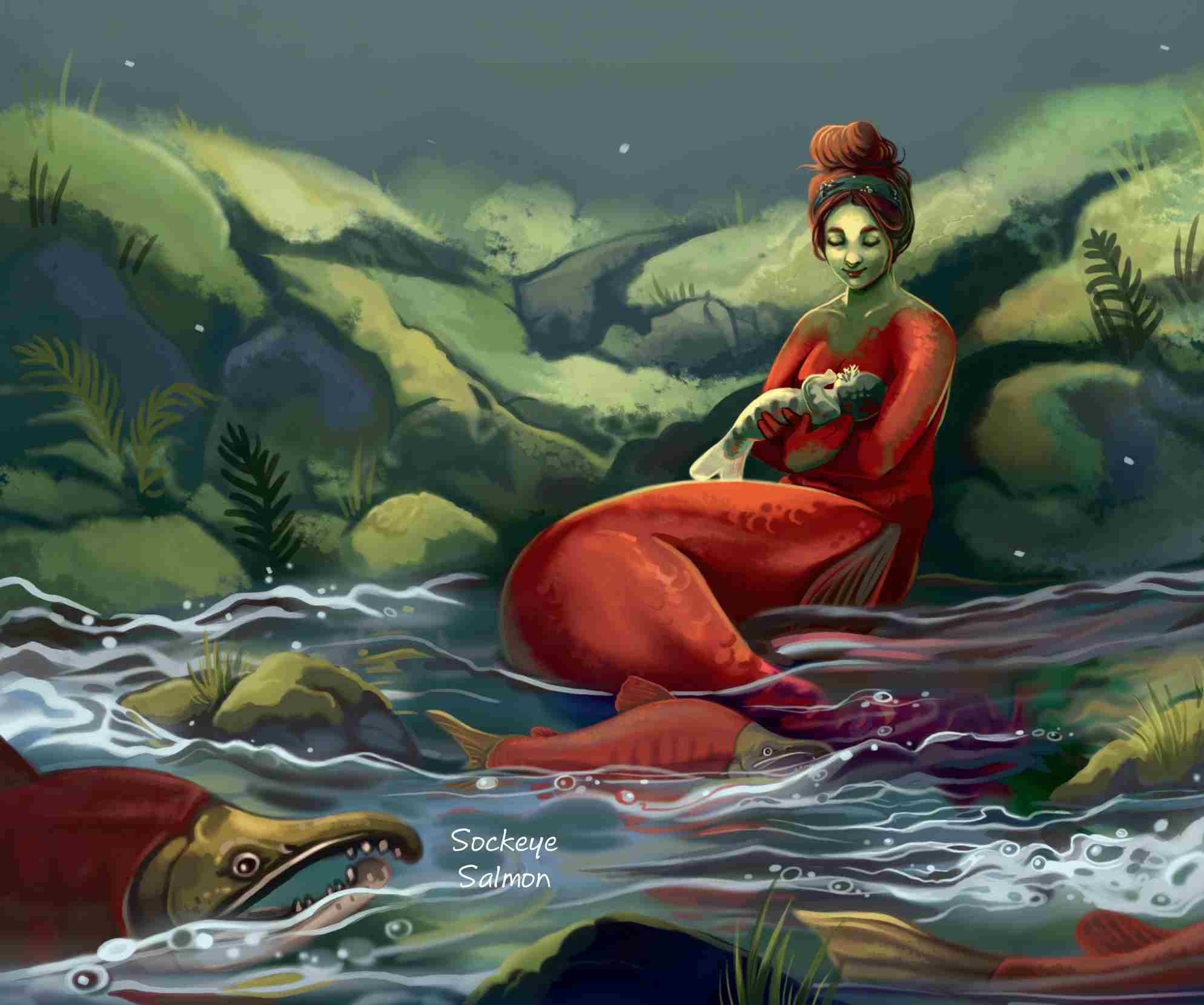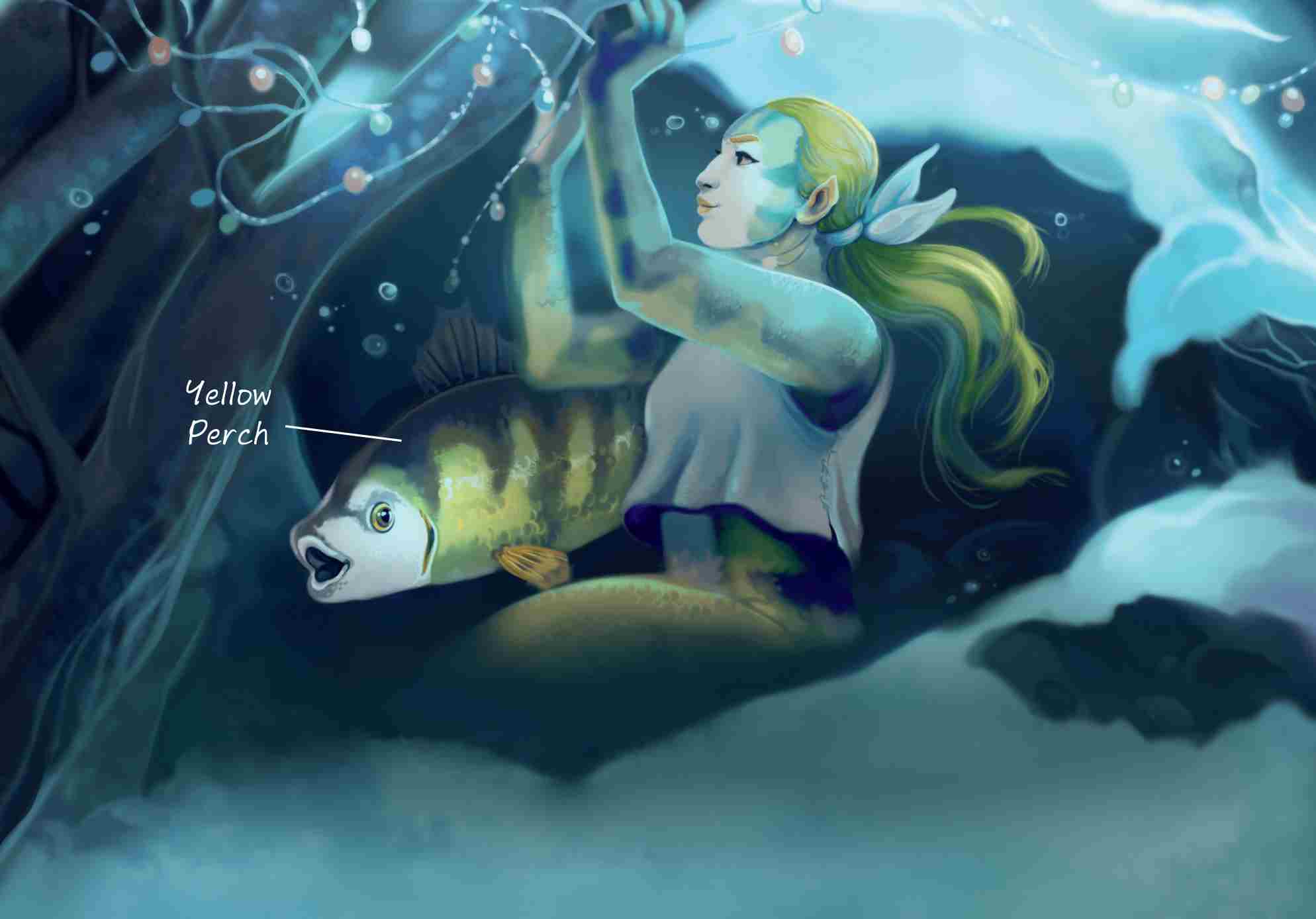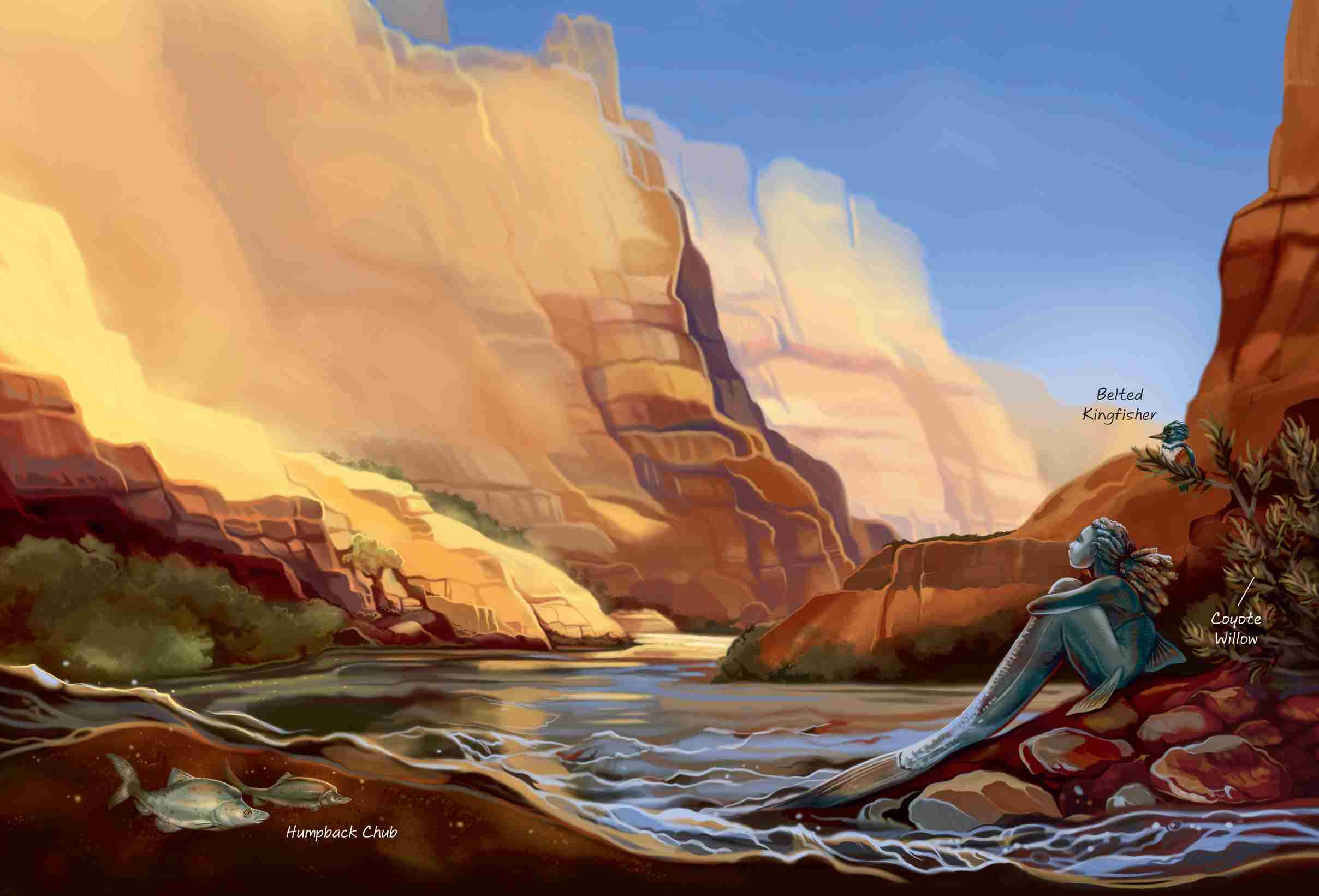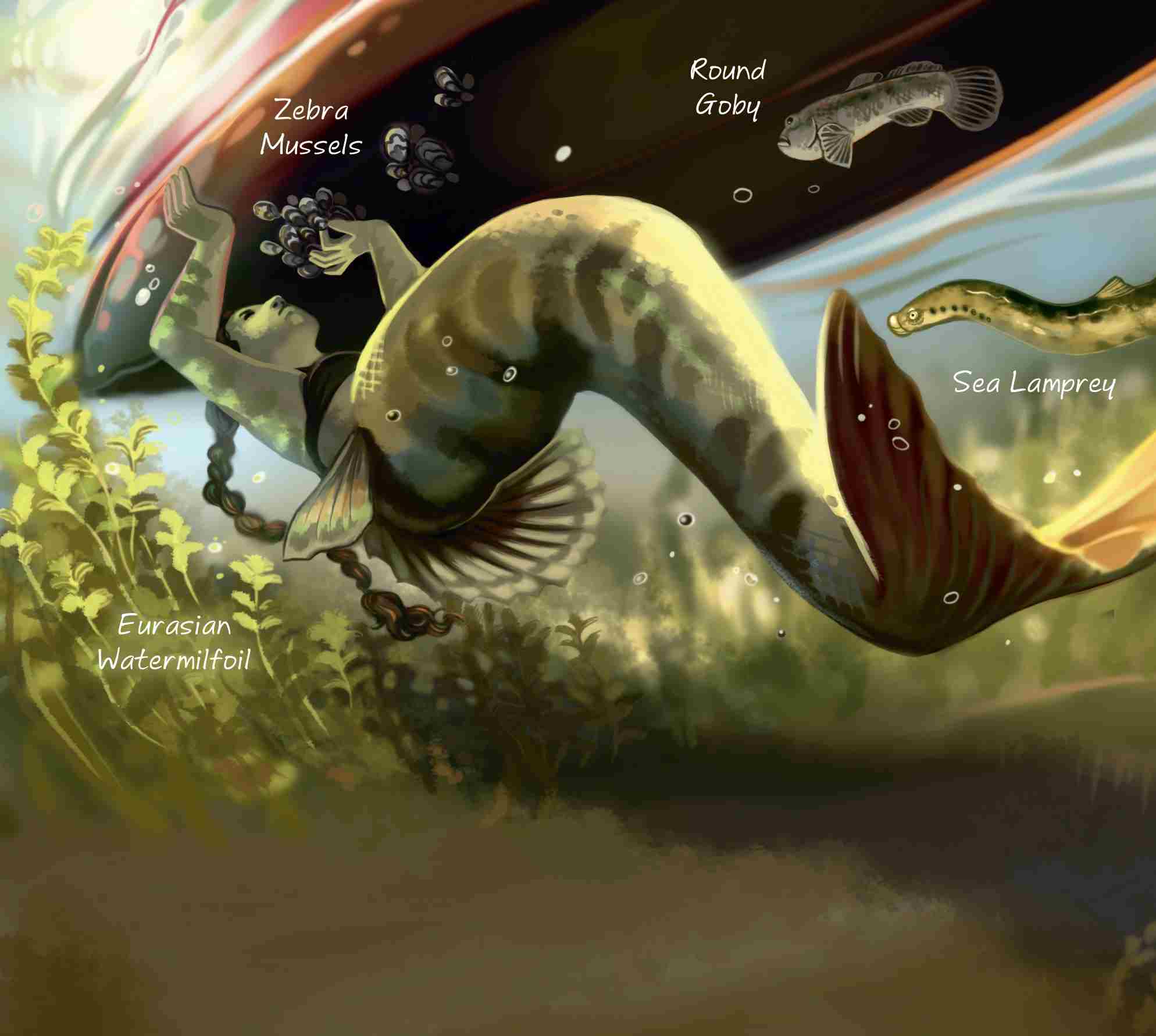MOVING FRESHWATER MERMAIDS

LIFE IN MOTION
Tiny springs bubbling up in high mountain meadows, thundering cascades churning with white foam, broad channels winding lazily toward the sea—life in streams and rivers is one of constant motion and change. Everything from food to rocks to trash tumbles down with the current. Floods scour the riverbed, changing the pattern of the banks. Water leaps over hillsides and boulders to form rapids and waterfalls. The mermaids who live in moving water are energetic and adaptable—just like their environment.
The smallest bodies of moving water are springs and brooks, which gather into streams and then into rivers. The nature of the habitat within them depends largely on what kind of land they’re passing through—rocky banks create rapids, while sandy banks create a gentler current. Some mermaids prefer the shallow, gravelly sections known as riffles, while others prefer the deeper, calmer pools, and yet others like the currents found in open channels.
When you are exploring streams and rivers to look for mermaids, you can ask yourself these questions:
- Do I know where this water comes from and where it flows to?
- Is the water shallow or deep? Is it clear or cloudy? How might that affect mermaids?
- Is the bottom rocky or sandy? How does that affect the movement of the water?
- Are there any obstacles mermaids might encounter?
- How might activities that happen upstream affect mermaids downstream?
- If I were a mermaid, what might I like about this habitat? What might be a problem?


HEADWATER STREAM MERMAIDS
Little River, TN
Up in mountain highlands, clear, cold springs bubble out of the ground and rush over rocky beds, between mossy banks, and under shady canopies. These are the birthplaces of great riverways, and they’re prime habitats for small creatures that like their water cool, swift, and clean.
ENDEMIC: native to one specific location and nowhere else in the world.
Mermaids in headwaters tend to be small and highly suited to life in these tumbling streams. They are strong swimmers, able to fight against turbulent currents and leap small cascades with little trouble. These mermaids are highly protective of the small, sensitive species sharing their homes. In the Little River in the mountains of Tennessee, for example, mermaids have a special relationship with endemic salamanders, and can often be found cuddling at least one of the amphibians as a human would a cat.
HIGHLAND RIVER MERMAIDS
Arkansas River, CO
Tiny mountain streams run together to form fast, rocky highland rivers. At these elevations, the water is pure, cold, and full of oxygen, like the headwaters of the Arkansas River in Colorado. These highland ecosystems can be both ideal and challenging for mermaids—while the water is less polluted than farther downriver, seasons bring intense change: ice and snowbanks in the winter, and foaming floods from snowmelt in the spring.
Mermaids in the Mountain West have a special relationship with American dippers, the United States’ only aquatic songbird. These pudgy little birds can dive into the water and walk along the bottom, feeding on aquatic insects. Mermaids often trail along with them, turning over rocks to reveal insect larvae.


FLATLAND RIVER MERMAIDS
Mississippi River, WI, IA, IL, MO
As they leave the mountains, highland rivers merge and become wider, slower, and sandier. One such river is the powerful Mississippi, which collects water from over half of the states in the US.
Flatland river mermaids are some of the largest and longest-living mermaids. Many of them have a passion for a very humble creature: the freshwater mussel. For a long time, scientists assumed this was because of mermaids’ fondness for pearls, which are created by mussels in fresh water and oysters in salt water. But there’s another reason for mermaids to care so much about these little shell creatures—mussels are vital to a healthy river ecosystem. They filter out nutrients and pollution, storing both in their bodies. Mermaids can often be seen lovingly tending their shell gardens in an effort to keep their rivers clean.
COASTAL RIVER MERMAIDS
Elwha River, WA
As rivers reach the coast, some become warm and slow, spreading out into swamps and marshes, while others are cold and fast, like the Elwha, which rushes out of the mountains to meet the sea. These rivers are home to anadromous mermaids—mermaids who spend most of their lives in the ocean before traveling into coastal freshwater rivers, along with many kinds of fish. The fish make this journey to lay their eggs; likewise, mermaids make this journey to have their babies in the same safe, protected streams they were born in.
The swim up these coastal rivers is never easy—mermaids have to fight against rapids and leap up cascades, dodging predators all the while. Some swim for miles to reach their safe, familiar childhood streams.

MERMAID TAILS
One of the most eye-catching and important features of any mermaid is her tail. These tails can come in all shapes, sizes, and colors, and they can mimic the tails of almost any kind of aquatic animal. Many mermaid tails are covered in scales, which help protect their skin and decrease drag through the water. Other tails are covered in smooth or rough skin, bony plates, or even waterproof fur, like a seal!
Most mermaids also sport fins on their tails. These are membranes that help them maneuver and balance in the water. Fins can be spiny, fleshy, or soft and flexible like fabric. Usually, fins come in pairs, with one pair on either side of the mermaid below her hips and another pair along her spine. The fin at the end of a mermaid’s tail is called a caudal fin and can come in a wide variety of shapes. Mermaids with forked or heterocercal tails are the fastest swimmers—they’re often found in ocean environments, where there’s lots of room to build up speed.

Another important feature of a mermaid’s tail is the lateral line. This is a sensory organ that runs down both sides of a mermaid’s body that helps her detect movement and electrical charges in the water. This means that even in very dark or murky water, mermaids can sense the approach of objects and other animals, which helps them navigate their environments without relying on their eyesight.

The depth of water affects how different mermaids move—those in shallow water, like streams, tend to move their tails side to side, while those in deep water, like the open ocean, often move their tails up and down.
BRAIDED RIVER MERMAIDS
Platte River, NE
Just like the strands of braided hair, braided rivers are made up of many meandering water channels that part and weave. These types of rivers carry sand and silt from upriver and deposit them as midstream islands that shift all the time. These wide, shallow waterways and the constantly changing islands within them create havens for all kinds of animals, especially migrating birds.
Mermaids in braided rivers navigate the winding waterways with ease. They can often be spotted lounging on the sandy islands, safe in the middle of the river. When threatened, they will slip back into the water and dart into the maze of interwoven river channels, becoming almost impossible to find again. They play a role in protecting important stopover grounds for migrating birds, like rustling up the minnows, frogs, and insects for them to eat, and chasing away predators.

CREATURE FEATURE
Whooping Cranes—Named for the “whooping” sound they make, these are the tallest birds in North America.
Sandhill Cranes—These birds are highly social and can flock together in the thousands.
BLACKWATER RIVER MERMAIDS
Suwanee River, GA, FL
Don’t be alarmed by the dark color of the water—it’s perfectly natural and a highly unique ecosystem. Blackwater rivers are usually found flowing through swamps, like the Suwanee River, which begins in Okefenokee Swamp in Georgia. The water is darkened by chemicals called tannins seeping out of decaying plants, turning it the color of tea. Though the water might look dirty, these tannins actually help purify it.
The current tends to be slow, and because of all the decaying life in the water, these rivers are low in dissolved oxygen. This means blackwater river mermaids are often found lounging partially out of the water, sunning on logs or banks with other animals and taking deep breaths of humid air with their lungs.


FREEZING RIVER MERMAIDS
Sheyenne River, ND
We’re used to thinking about mermaids and other aquatic creatures in summer. But mermaids don’t have the option to climb out when it gets too cold—they live in water all year round. So what do they do in the winter?
As temperatures drop, river mermaids face unstable conditions, with ice that forms, freezes, and breaks apart in unpredictable, sometimes dangerous ways. Ice first starts to form in tiny crystals that pile up, creating slush called frazil ice. This mushy ice can shift unpredictably, making it difficult to find a safe place to stay. Frazil ice can sometimes freeze in patches below the surface, creating anchor ice. This can build up into dams, draining pools downstream and cutting off mermaids and other animals from safer habitats.
But mermaids aren’t helpless. Some simply migrate downriver to warmer waters, or even to the ocean, to wait out the winter. Others are builders, constructing shelters to protect themselves and their vulnerable underwater friends during the cold months.

WATERFALL MERMAIDS
Big Bend Falls, SC, GA
Where the land drops away, waterfalls abound. Plunging downward, these falls can take the forms of wide curtains, dramatic ribbons, churning flumes, rippling cascades, or murmuring trickles. No matter their appearance, all waterfalls have significant impacts on the surrounding environment. They churn up oxygen and nutrients, hollow out pools, and create lush habitat along riverbanks that mermaids love.
Exceptionally tall or powerful waterfalls are natural barriers, though some strong mermaids will always manage to climb rocky slopes to reach the higher waters. Gentler waterfalls serve as favorite meeting places for upstream and downstream relatives.
CREATURE FEATURE
Darters—These small, quick fish are some of the most colorful freshwater fish in the United States. They only live in clean moving water and are often found only in a few small ranges separated by abundant waterfalls.
CANYON RIVER MERMAIDS
Colorado River, AZ
Moving water is a powerful force—whether as a trickle or a flood, it can carve its way through solid rock, leaving behind cliffs, mesas, and canyons. Many of our most dramatic landforms were carved by flowing water, and few rivers have created more stunning scenery than the Colorado River. On its way down from the Rocky Mountains, it has cut a path for itself through the arid Southwest, forming some of our most well-known and best-loved landmarks, like the Grand Canyon.
Life for a mermaid in a canyon river like the Colorado can be full of surprises. Canyon mermaids must be on their guard for heavy rapids, sudden rises or drops in water levels, and boulders careening downstream. They are experts at navigating the cloudy, churning waters and thrive in the sun-warmed shallows and deep secret pools.

Like many canyon rivers, the Colorado is not as wild as it once was. Dams built along its course trap water, no longer allowing the seasonal floods that used to rush through and carve away the canyon walls. While this might seem like a bonus to mermaids, most are not adapted to the calmer, clearer, and colder waters released at the base of dams. Dams have also stopped the migration of many mermaids who used to be able to travel freely up and down its historic rapids. Mermaids and fish in canyons, who used to be so fit for their unique, exciting environment, are struggling to adapt to the human-caused changes in their rivers.
KARST SPRING MERMAIDS
Jacob’s Well, TX
Karst is a type of landscape that forms when water wears away the rock around it, especially limestone. This erosion forms caves, sinkholes, and underground rivers. Sometimes these rivers bubble up to the surface, forming karst springs that flow into lakes or streams, such as Jacob’s Well in Texas, which flows up into Cypress Creek.
Unlike rivers that are completely hidden in caves, water in a karst spring may disappear into the ground in one place and emerge in another after traveling through the underground maze of dissolved limestone. This means that despite the appearance of living in a small creek, mermaids in these types of karst habitats can actually travel incredible distances through flooded tunnels and underground rivers. Agile and canny, they can slither through sometimes small openings in the rock that connect one underground passage to another.


CANAL MERMAIDS
Erie Canal, NY
Canals are human-made rivers. In the days before highways and airplanes, canals were the best way to move heavy cargo around, and many are still used today for shipping.
INVASIVE SPECIES: a plant or animal not native to an ecosystem that causes damage to native species. The plants and animals shown here are invasive.
Canals also changed the environment, connecting bodies of water that had never been connected before. When the Erie Canal was completed in the 1800s, mermaids from the Atlantic and the Hudson River could now make their way into the Great Lakes, and vice versa. And while this gave some opportunity for making new friends, it also let in a host of invasive species, like sea lamprey, which preyed on lake trout, and aquatic weeds, which crowded out native plants. Even new mermaids put strains on the ecosystem. These days, mermaids use canals to travel and visit new places, but they also patrol them to keep down invasive plants and animals.
URBAN RIVER MERMAIDS
Delaware River, NJ, DE, PA
Big cities often spring up along rivers—after all, the more people in one place, the more water they’ll need to drink and use for cooking, cleaning, and working. Rivers have also played a vital role in travel and shipping, whether in small canoes or giant barges. All this activity means that urban rivers are busy, crowded places. In many cases, it also means they are polluted and blocked by human-made objects like dams. For a long time—and still in some ways today—rivers were used as dumping grounds for sewage, garbage, and other waste; eventually, many species have been driven out, unable to survive.

Mermaids, like so many other aquatic animals, need clean water and the ability to travel freely through their habitat. This is why mermaids are often absent from urban rivers. But some cities have worked to restore the health of their water. The Delaware River, which provides drinking water to many major cities on the mid-Atlantic coast—like New York City, Philadelphia, and Trenton—is now the longest river in the United States that doesn’t have a dam on its main stem, which means mermaids and fish can travel the same routes they always have. This provides an important habitat for catadromous mermaids and fish, which are the opposite of anadromous mermaids and fish (see Coastal Rivers for more). Catadromous fish, like the American eel, migrate from fresh water to spawn in the ocean. Thanks to the undammed water and lower pollution of the Delaware, catadromous mermaids are still able to swim out to sea to have their babies.